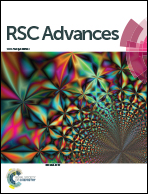Glucose-assisted hydrothermal synthesis of few-layer reduced graphene oxide wrapped mesoporous TiO2 submicrospheres with enhanced electrochemical performance for lithium-ion batteries†
Abstract
A facile and green strategy for the synthesis of a few-layer reduced graphene oxide (FL-RGO)-wrapped mesoporous anatase TiO2 (m-TiO2) submicrosphere (denoted as m-TiO2@FL-RGO) composite was developed via glucose-assisted hydrothermal GO reduction and TiO2 crystallization. In this approach, glucose is important for tightly immobilizing FL-RGO on the surface of the m-TiO2 submicrospheres. The wrapping of FL-RGO improves the electrochemical kinetics of the m-TiO2 submicrospheres, which results in superior electrochemical performance in terms of specific capacity, rate capability and cycle stability. The material shows a discharge capacity of 202.5 mA h g−1 at 0.6C after 100 cycles. Even at a current rate of 30C, a high discharge capacity of 113.5 mA h g−1 is still obtained, which is two-fold higher than that of pristine m-TiO2 submicrospheres. The superior electrochemical performance offered by the m-TiO2@FL-RGO composite is attributed to the enhanced electronic conductivity due to the graphene wrapping and effective diffusion of Li ions in the interconnected network of nanoparticles forming the mesoporous anatase TiO2 submicrospheres.


 Please wait while we load your content...
Please wait while we load your content...